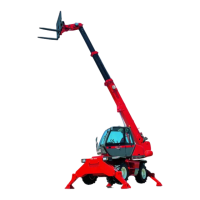1-6
IT EN FR
648970 IT-EN-FR (18/02/2016)
The user must remain in full control of his lift
truck and should:
- Adapt his speed to each situation in
order to be maintain his own safety,
that of others and of his equipment.
- Always be aware of his stopping
distance.
On the basis of experience, there are a
number of possible situations in which
operating the lift truck is contra-indicated.
Such foreseeable abnormal uses,
the main ones being listed below, are
strictly forbidden.
- The foreseeable abnormal
behaviour
resulting from ordinary neglect, but
does not result from any wish to put
the machinery to any improper use.
- The reflex reactions of a person in the
event of a malfunction, incident, fault,
etc. during operation of the lift truck.
- Behaviour resulting from application of
the “principle of least action” when
performing a task.
- For certain machines, the foreseeable
behaviour of such persons as :
apprentices, teenagers, handicapped
persons and trainees tempted to drive
a lift truck. Truck drivers tempted to
operate a truck to win a bet, in
competition or for their own personal
experience.
The person in charge of the equipment
must take these criteria into account when
assessing whether or not a person will make
a suitable driver.
- Get to know the telescopic fork lift
truck on the terrain where it is to be
used.
- Transport the load with the boom
lowered and fully retracted
- Position the forks at right-angles to the
load to be lifted.
- Drive the truck at a speed appropriate
to conditions and the state of the
ground.
- Never go too fast or brake sharply with
a load.
- When picking up a load, check that the
ground is as even as possible.
L’utilizzatore deve sempre poter controllare il
carrello elevatore e
quindi deve:
- Adattare la velocità ad ogni situazione
per preservare la propria incolumità,
quella altrui e quella della propria
macchina.
- Valutare continuamente lo spazio di
frenata.
L’esperienza ci insegna che si possono avere
alcune controindicazioni sull’impiego del
carrello elevatore. Questi impieghi anomali
prevedibili, di cui i principali sono elencati qui
di seguito, sono formalmente vietati.
- Il comportamento anomalo prevedibile,
che risulta da una negligenza ordinaria,
ma che non risulta dalla volontà di fare
un cattivo uso della macchina.
- Il comportamento riflesso di una persona
in caso di cattivo funzionamento,
d’incidente, di anomalia, ecc. durante
l’utilizzo del carrello elevatore.
- Il comportamento risultante
dall’applicazione della “legge del minimo
sforzo” durante l’esecuzione di un
compito.
- Per alcune macchine, il comportamento
prevedibile di certe categorie di persone,
quali: apprendisti, adolescenti, portatori
di handicap, personale in
formazione.
I carrellisti tentati di utilizzare il carrello
elevatore per scommesse, competizioni o
per esperienza personale.
Il responsabile dello stabilimento deve
tenere conto di questi criteri per valutare
l’attitudine alla guida di una persona.
- Prendere confidenza con il carrello
elevatore telescopico sul terreno dove
sarà utilizzato.
- Trasportare il carico in posizione bassa
e il braccio telescopico rientrato al
massimo .
- Posizionare le forche
perpendicolarmente al carico da
sollevare.
- Guidare il carrello ad una velocità
adeguata alle condizioni e allo stato
del terreno.
- Non andare mai troppo forte né frenare
bruscamente con un carico .
- Al momento di prendere un carico,
verificare che il terreno sia il più
uniforme possibile .
L’utilisateur doit rester maître de son chariot
élévateur donc:
- Adapter la vitesse à chaque situation
pour préserver sa sécurité, celle d’autrui,
et celle de son matériel.
- Apprécier en permanence la distance
d’arrêt.
D’après
l’expérience, certaines contre-indications
d’emploi du chariot élévateur peuvent
se présenter. Ces utilisations anormales
prévisibles, dont les principales sont citées
ci-dessous, sont formellement interdites.
- Le comportement anormal prévisible qui
résulte d’une négligence ordinaire, mais
qui ne résulte pas de la volonté de faire
un mauvais usage du matériel.
- Le comportement réflexe d’une personne
en cas de dysfonctionnement, d’incident,
de défaillance, etc., en cours d’utilisation
du chariot élévateur.
- Le comportement résultant de
l’application de la “loi du moindre effort”
au cours de l’accomplissement d’une
tâche.
- Pour certaines machines, le
comportement prévisible de certaines
personnes telles que: apprentis,
adolescents, personnes handicapées,
stagiaires tentés de conduire un chariot
élévateur. Les caristes tentés soit
d’opérer une utilisation en vue de paris,
de compétition, à titre d’expérience
personnelle.
Le responsable du matériel doit tenir compte
de ces critères pour évaluer l’aptitude à
conduire d’une personne.
- Se familiariser avec le chariot sur le terrain
où il devra évoluer.
- Transporter la charge en position basse, le
télescope rentré au maximum..
- Positionner les fourches perpendicul
rement à la charge à soulever.
- Conduire à une vitesse approprié aux
conditions et a l’état du terrain.
- Ne jamais aller trop vite ni freiner brus
quement avec une charge.
- En prenant une charge s’assuer que le
terrain est aussi plat que possible.

